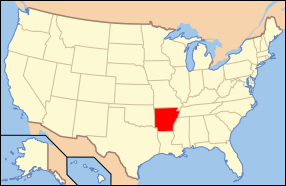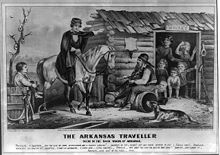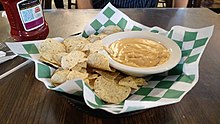Culture of Arkansas

| This article is part of a series on the |
| Culture of the United States |
|---|
 |
| Society |
| Arts and literature |
| Other |
| Symbols |
|
United States portal |
The culture of Arkansas is a subculture of the Southern United States that has come from blending heavy amounts of various European settlers' cultures with the cultures of
On a more abstract level, Arkansas's culture can be seen and heard in its literature, music,
People
The people of Arkansas are stereotyped both by their manners and for being highly religious. Language in Arkansas is a combination of several different sub-dialects of Southern American English found across the state. The state's culture is also influenced by its economy. Finally, Arkansas' cuisine is integral to its culture with such foods as barbecue, traditional country cooking, fried catfish and chicken, wild duck, rice, purple hull peas, okra, apples, fried green tomatoes and grits being part of the people of Arkansas's diet and economy.[citation needed]
Reputation of Arkansas
The
Origins

The present day image of Arkansas has evolved from early diary entries written by the first visitors to the state. During the frontier period, many were exploring the new western extents of the United States and sending their findings back east. Henry Schoolcraft, George William Featherstonhaugh, and Henry Merrill were some of Arkansas's earliest detractors.[2] Their accounts described the state as a backwater full of savages and outlaws. The travelers also commented on the self-sufficient nature and the wide range of survival skills possessed by the denizens of frontier Arkansas.[3] This characterization was common among frontier states, but since geography prevented travelers from passing through Arkansas in subsequent years, the early commentary held in the public consciousness.[4]
The image continued to grow when southwestern humor publications played on the backwardsness of poor whites, especially in hill country.
Racist component
Another component of Arkansas's image is its history of racism and racial violence. Arkansas is
Southern dialect in Arkansas
Gov.
Oxford University in England and Yale Law School in the Ivy League, two of the finest institutions of learning in the world. So how come you still talk like a hillbilly?
—Quote exhibiting the assumed link between accent and education, Mike Royko, 1992.[9]
Many Arkansans speak with a Southern dialect or accent, although it is generally characterized as an
Anecdotes of Northern accent-holders disrespecting and dismissing the intelligence of those with Southern dialects are largely the result of popular culture's portrayal of the South, including Gone With the Wind, The Beverly Hillbillies, and Deliverance.[12] Rosina Lippi, author and holder of a PhD in linguistics, has commented that Northerners use the link to ignorant, lazy Southerners to denigrate the South.[11] Since Southerners are a group connected by a common culture and history rather than a race defined by ethnic characteristics, the North uses the Southern accent to appeal to stereotypes[11] of the region that are otherwise uncomfortable topics, such as racism.[13] The belittlement of Southern dialect speakers has been effective[11] to the point at which classes on losing one's Southern accent are offered for those looking to move and work in the North.[14]
Food and drink
Meats, poultry, fish and seafood

Arkansas lies among three well-known
The smoked meat tradition was very important to early settlers to preserve meat, as the smokehouse was one of the Arkansas settler's most important outbuildings.[19] Hog hunts and pig roasts were community events in early Arkansas.[20]
Popular restaurant dishes include
Other traditional meat entrees include hamburger steak with gravy and onions and fried dishes (
-
Twice cooked chicken, potato salad, purple hull peas, corn bread, and iced tea
-
Chicken fried steak, corn nuggets, purple hull peas
-
BBQ beef sandwich and smoked beans
-
Shrimp and potatoes
-
Ribs, potato salad, baked beans, and bread
-
Tamales
-
Smothered chicken, mashed potatoes and gravy, macaroni and cheese and roll
-
Fried chicken
-
BBQ sandwich and baked beans
-
BBQ beef platter with baked beans and coleslaw
-
Tamales platter
Side dishes and condiments

Cheese dip, sometimes referred to as
Sweets
Early Arkansas settlers relied on
-
Fried pickles
-
Governor Asa Hutchinson (left) and US Representative Mike Ross (second from left), competes in the annual watermelon eating competition in Hope
-
Fried catfish, purple hull peas, and hot water cornbread
-
Fried catfish, mashed potatoes and gravy, and greens
Restaurants
Little Rock's Lassis Inn was a meeting place for civil rights leaders in the 1950s and 60s, including Daisy Bates, while they were planning efforts such as the desegregation of Little Rock Central High School.[29][30][31][32][33] In 2017 it was among the three inaugural inductees into the Arkansas Food Hall of Fame, along with Rhoda's Famous Hot Tamales and Jones Bar-B-Q Diner.[34][35] In 2020, it was named an America's Classic by the James Beard Foundation. [34][36]
Arts
Architecture

The architecture of Arkansas varies wildly, whether one is looking across the street, across the city, or across the state. Architecture can be divided into two main branches: folk houses and structures in a traditional sense and buildings built in a specific style to follow a trend or explore a new style.
The historical timeline of architecture in Arkansas is similar to that of the nation. Throughout the 1800s three styles vied for dominance:
A variety of architectural styles became popular in Arkansas in the 20th century, including
Early settlers began by fabricating log structures and shacks using available materials.
Literature
Early literature about Arkansas shortly after statehood in 1836 describes Arkansas as a savage backwater populated by lazy farmers and unintelligent slaves. Arkansas was also frequently the subject of Southwest humor pieces, a genre in which exaggeration and hyperbole is used for comedic effect. Some of these images stuck in the public conscience, and are partially responsible for the "Arkansas hillbilly" stereotype still commonly applied today. Literature from Arkansas natives often bears the mark of the state's varied geography. The culture of rural Arkansas towns is reflected in works like I Know Why the Caged Bird Sings by Maya Angelou (based in Stamps, Arkansas) and John Grisham's A Painted House (based in Black Oak, Arkansas). The University of Arkansas Press is the state's largest publisher.
Music
Performing arts

The state of Arkansas has a few theaters for the performance arts, including the Walton Arts Center in Fayetteville, the Arkansas Public Theatre in Rogers, the Robinson Center in Little Rock, and the King Opera House in Van Buren. The Arkansas Arts Council supports a group of touring performers as well as providing financial support for the performing arts.[38] Arkansas Repertory Theatre, based in Little Rock, is the state's largest non-profit theater company. Northwest Arkansas also has a regional theater company, TheatreSquared, the region's only year-round theater. TheatreSquared has received recognition from the American Theatre Wing and focuses on youth arts education in addition to their 100+ performances annually.
Little Rock hosts the
Museums

The museums in Arkansas display and preserve the culture of Arkansas for future generations. From fine art to history, Arkansas museums are available throughout the state. The most popular museum in Arkansas is
History museums interpret the history of the state for Arkansans and tourists, and are located across the state. The
The Department of Arkansas Heritage operates four different museums in Arkansas including the
Sports

Sports are an integral part of the culture of Arkansas, and its residents enjoy participating and spectating various events throughout the year. One of the oldest sports in Arkansas is hunting. The large supply and cheap production of guns following the
Football, especially collegiate football, has always been important to Arkansans, primarily because of a lack of a top level professional sports team. College football in Arkansas began from humble beginnings. The
See also
Notes
- ^ "Arkansas/Arkansaw: A State and its Reputation". Old State House Museum. Archived from the original on November 14, 2012. Retrieved October 20, 2012.
- JSTOR 40026271.
- ^ Blevins 2009, pp. 14–15.
- ^ Blevins 2009, p. 16.
- ^ "Traditions in Southern Humor". American Quarterly. 5 (2). The Johns Hopkins University Press: 113. Summer 1953.
- ^ a b Blevins 2009, p. 30.
- ^ "The Arkansas Traveler". Bentonville, Arkansas: Crystal Bridges Museum of American Art. Retrieved December 4, 2020.
- JSTOR 40026271.
- ^ Royko, Mike (October 11, 1992). "Opinion". Chicago Tribune.
- ISBN 978-0879109677.
- ^ a b c d Lippi-Green 1997, p. 212.
- ^ Lippi-Green 1997, pp. 209–210.
- ^ Lippi-Green 1997, pp. 215–216.
- ^ Collins, Jeffery; Wyatt, Kristen (November 24, 2011). "Hey, y'all, want to lose the drawl?". USA Today. Retrieved January 30, 2013.
- ^ "McDonough" (1975), pp. 2–3.
- ^ "Slaw" (2012), p. 27.
- ^ "Slaw" (2012), pp. 28–29.
- ^ "Slaw" (2012), pp. 30.
- ^ "McDonough" (1975), p. 67.
- ^ "McDonough" (1975), pp. 67–68.
- ^ Wells, Lindsey (May 27, 2018). "Nationally-recognized barbecue restaurant celebrates 90 years". Hot Springs Sentinel-Record. Hot Springs, Arkansas. Retrieved August 3, 2019.
- ^ Van Zandt, Emily (June 5, 2014). "Still Hot on Tamales". Arkansas Life. Archived from the original on August 4, 2019. Retrieved August 3, 2019.
- OCLC 36098632. Retrieved August 3, 2019.
- OCLC 25174115.
- ^ "McDonough" (1975), pp. 67–68.
- ^ "McDonough" (1975), p. 160.
- ^ "McDonough" (1975), pp. 167–168.
- ^ Alexander, Amber. "Water from a Tree – Making Maple Syrup in the Ozarks". Edible Ozarkansas (6). Fayetteville, Arkansas: Feed Communities, Inc.: 14–20.
- ^ "Encyclopedia of Arkansas". Encyclopedia of Arkansas. Retrieved February 28, 2023.
- ^ "Announcing the 2020 America's Classics Winners". www.jamesbeard.org. Retrieved February 28, 2023.
- ^ "Lassis Inn". Arkansas.com. Retrieved February 28, 2023.
- ^ Kraft, Chris (February 26, 2020). "What an "America's Classic" Award Can Do". Garden & Gun. Retrieved February 28, 2023.
- ^ "The sites in this guide are a key part of understanding America's story". NPR. July 30, 2022.
- ^ a b "Encyclopedia of Arkansas". Encyclopedia of Arkansas. Retrieved February 28, 2023.
- Arkansas Online. Retrieved February 28, 2023.
- ^ "James Beard Foundation Names 6 Restaurants 'American Classics'". Food & Wine. Retrieved February 28, 2023.
- ^ "National Register Information System". National Register of Historic Places. National Park Service. July 9, 2010.
- ^ Parker, Tina (August 23, 2012). "Eureka arts programs awarded $29K in grants". Carroll County News. Retrieved August 24, 2012.
- ^ "Arkansas Arts Center presents 55th annual Delta Exhibition". Stuttgart Daily Leader. Gatehouse Media, Inc. January 21, 2013. Retrieved February 4, 2013.
- ^ Hall, Christopher (August 22, 2010). "North Little Rock Finds its Cool". Travel. The New York Times. Retrieved February 4, 2013.
- ^ "McDonough" (1975), p. 186.
- ^ Bartels, Chuck (November 12, 2012). "600K visitors later, Crystal Bridges turns 1". Seattle Post-Intelligencer. Retrieved November 18, 2012.[permanent dead link]
- ^ Reynolds, Chris (October 14, 2012). "Crystal Bridges art museum is reshaping Wal-Mart's hometown". Chicago Tribune. Retrieved November 18, 2012.
- ^ Griffee, Carol. "Odyssey Of Survival, A History of the Arkansas Conservation Sales Tax" (PDF). p. 10. Archived from the original (PDF) on January 17, 2013. Retrieved September 16, 2012.
- ^ "Arkansas matchup is not likely soon". Sun Herald. July 20, 2003. p. 9B.
References
- Blevins, Brooks (2009), Arkansas/Arkansaw, How Bear Hunters, Hillbillies & Good Ol' Boys Defined a State, Fayetteville, Arkansas: ISBN 978-1-55728-952-0
- McDonough, Nancy (1975), Garden Sass: A Catalog of Arkansas Folkways, New York, NY: Coward, McCann & Geoghegan, LCCN 74-16633
- ISBN 978-0415114776
- Veteto, James R.; Maclin, Edward M., eds. (January 30, 2012), The Slaw and the Slow Cooked, Nashville, Tennessee: Vanderbilt University Press, ISBN 9780826518019















